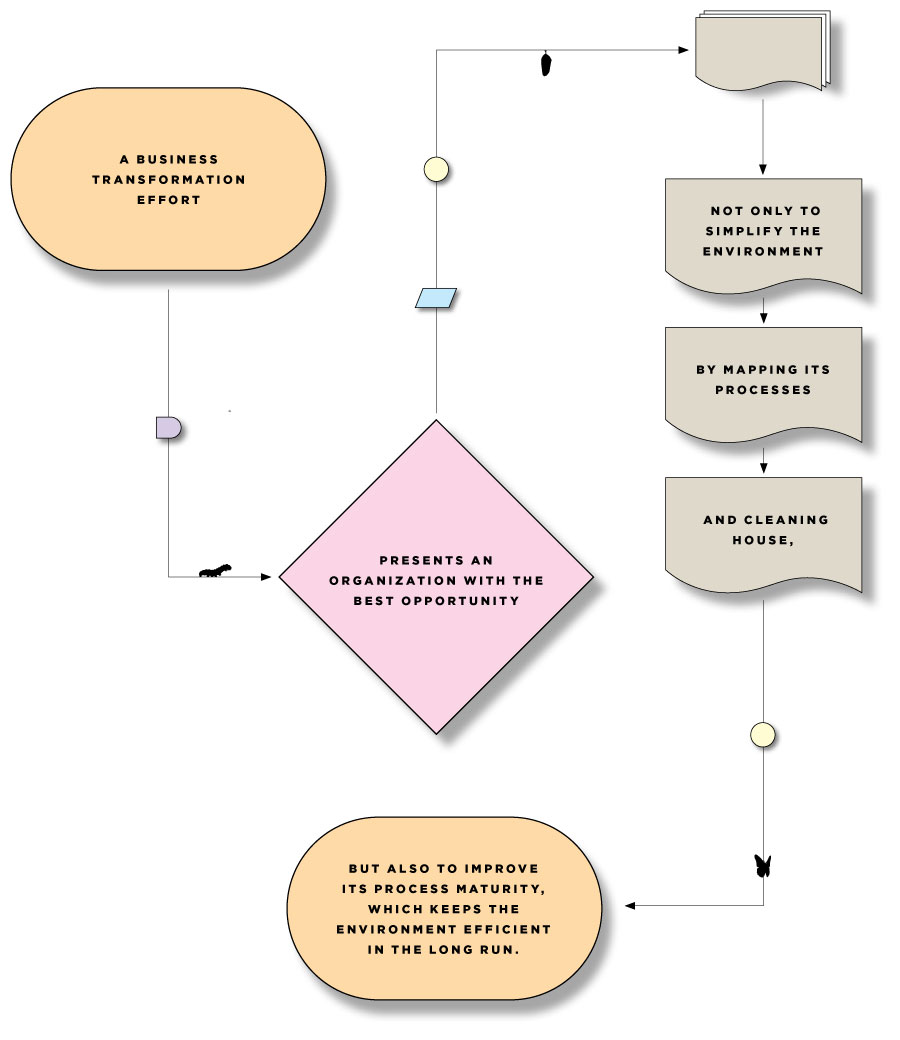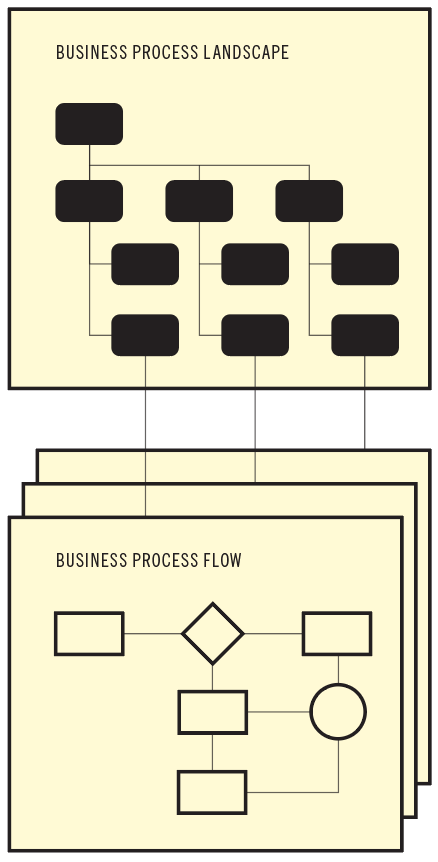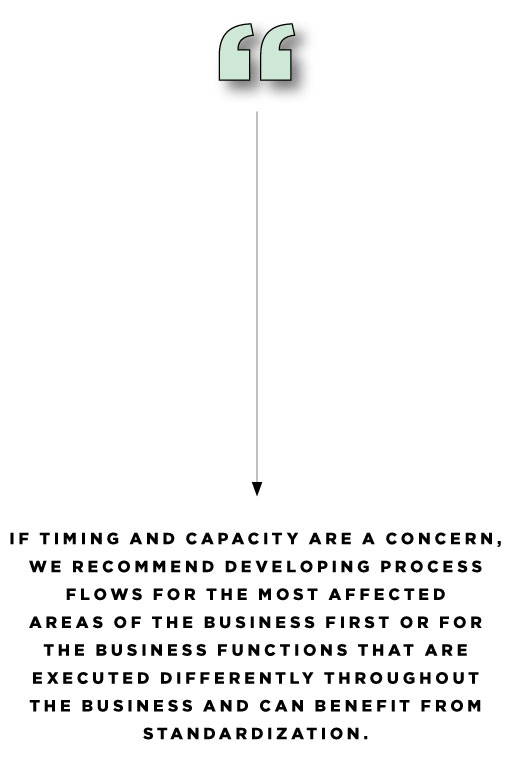The definition of a “transformation” is not just to improve how you operate today but to fundamentally change the way you do business. Transformations take many forms as they enable an organization to move in an entirely different direction and gain a new level of effectiveness to achieve breakthrough results. They cut deep and dramatically affect how an organization operates and adds value, usually by leveraging new capabilities.
In the last issue of The Jabian Journal, the article “Understanding the Transformation Journey” (Fall 2019) explored why almost 70 percent of transformations fail to achieve their business case. While culture and technology are key to most transformations and deservedly get a lot of attention, this article will focus on the other critical component of a transformation: the business process.
Business Processes – the means by which organizations get work done and add value.
As a critical component of any capability, a business process is the fundamental element of change in an organization. When the change is dramatic enough to cause an organization to embark on a transformation journey, business processes should be used as the blueprints to guide that journey.
A SUCCESSFUL BUSINESS TRANSFORMATION STARTS WITH ENSURING
THAT ALL PROCESSES ARE ALIGNED WITH THE ORGANIZATION’S FUTURE GOALS.
Demystifying the Journey
The impetus for many transformation efforts is the so-called “burning platform,” which may take the form of failing systems, dropping profits, or an eroding market position. The imagery of the burning platform metaphor is enough to turn many efforts into a sprint against time. When the pressure to achieve results builds up, the transformation can seem like a monumental task and the journey a complex endeavor.
In the face of uncertainty brought on by the complexity of a transformation, a business and process analysis (BPA) methodology ensures that the business processes of an organization act as the blueprint to demystify the transformation journey and align the organization.
Using a framework and principle-based approach, the BPA methodology ensures that strategic objectives are analyzed to determine their impacts on and alignment with all aspects of the business. Most importantly, BPA makes business processes the foundation for any effort in an organization—incremental improvement efforts and large-scale transformations alike.
Using Processes as a Blueprint
1. Understand Current Realities
So how do you actually use processes as a blueprint for transformation? A common mistake is to design a solution before understanding the current realities and the unique value proposition of the organization. Many organizations have fallen into the trap of ignoring how they produce value and where the value chain is breaking down. As a result, they have automated the wrong processes, solved the wrong problems, or addressed symptoms rather than root causes. Without a thorough understanding of the current state, an organization cannot determine an achievable vision for the future or design the journey to get there. Misinterpreting the current state of the business processes and capabilities can make the journey more treacherous than it needs to be. This common mistake can lead to misjudged priorities and misplaced investments. Eventually, it can even overwhelm the organization, leading to another failed project or another missed opportunity for transformation.
Therefore, it is critical for an organization considering a transformation to carefully and honestly analyze its current environment and understand the nature and causes for system, process, and communication breakdowns before planning the transformation journey.
2. Transformation Is Not Just About Technology
The temptation is to jump right into new and exciting use cases for technology or to position the technology as the primary value creator to show quick impact. However, we have found it is critical to understand the current environment by reviewing the existing processes, workflows, and pain points before technology solutions are evaluated.
Even in times of urgency driven by the burning platform, it is crucial to take the time to focus on value creators of the organization and consider the needs of the customers, employees, and business. This is where process and structure become a critical workstream.
BPA helps organizations figure out how they create value, where breakdowns occur, and which parts of their workflows require attention. BPA also allows for redesigning for efficiency, effectiveness, reliability, and consistency. With the understanding of value chains and bottlenecks, leaders can home in on the areas where technology has the greatest potential to maximize return on investment. For example, while a new state-of-the-art call center system will make customer support more efficient, addressing the quality problems at the root of the high call volumes may have a bigger impact on customer satisfaction. While technology may be at the core of the burning platform and the impetus for change, it’s likely not the only driver behind a transformation or the main benefit an organization would gain.
3. Reduce the Complexity
No matter how simple and standard your business environment was designed at the beginning, the current process environment has likely become encumbered with inefficiency and complexity over time. Although no one sets out to design a complex solution, it is natural to expect that as soon as the implementation is completed, enhancement requests will be submitted to address emerging business needs. A new market segment, a new product line, entry into a new online marketplace, or even the consolidation of two existing locations may have added exceptions to the environment. Consequently, the exception-handling routines, the patches, and the workarounds applied to the legacy IT systems make them hard to integrate or update efficiently.
Throwing in new technology solutions to an existing environment that has been overly complicated by years of “accommodating” will entrench those complexities into your business for another generation. After all, IT acts like cement to standardize activities and codify business processes. Once implemented, the IT solutions prevent erosion of the processes and make it harder to revert to the starting state. When done right, a technology solution that automates a well-defined and understood process provides the organization with a standard and efficient way to achieve its goals. However, if the IT systems are implemented into an environment with inefficient, unclear, or broken processes, these also will be cemented into the fabric of the organization, haunting it for years to come.
The better practice is to keep the solution simple and standard. Developing the initial solution this way is the first step of the battle. Limiting the introduction of complexities and inefficiencies into that solution over time is the bigger challenge, and this is where the initial focus on process pays dividends. Like a blueprint, well-defined and -documented processes continue to convey the original design intent and guide future enhancements, helping limit the introduction of inefficiencies into the environment. The visual nature of drawing out processes allows stakeholders to see how complex a proposed process is and easily iterate to remove duplication of repeated activities.
We have found the maturity of the business process analysis and governance capability within an organization to be one of the biggest determinants of how complicated and inefficient the environment gets over time and how much time is wasted in rework.
A business transformation effort presents an organization with the best opportunity not only to simplify the environment by mapping its processes and cleaning house, but also to improve its process maturity, which keeps the environment efficient in the long run.
4. Create an Environment and Culture to Make the New Processes Stick
Most transformations fail due to the lack of adoption and eroding discipline for long-term use. Developing a solution behind closed doors or dropping an outside solution into an organization without analyzing the day-to-day process realities increases resistance and impedes progress. Employees’ understanding and buy-in are key prerequisites for any new process to stick.
We have achieved success by starting transformation efforts with alignment around business processes and heatmapping the impacted areas with employee experts. This approach has allowed stakeholders to align on a common language and fully think through where in the organization the impacts of the transformation would be. We call the artifacts produced in these business analysis efforts the “common reference models” because they serve as the reference for a team of people to effectively communicate ideas. These models not only get early involvement of employees in solutions, but they also serve as effective communication tools to align stakeholders and keep executives informed.
As such, BPA activities conducted early in a transformation can serve as a sound change management approach, creating the business and cultural environment for the new solution to stick.

5. Create Common Reference Models
The term “common reference models” is indicative of anything that a team can refer to and use for communication of an idea. Process frameworks enable more airtight scoping by helping to avoid key missing areas of the business or stakeholders. There are two common process reference models we’ve found extremely helpful for transformations: the business process landscape and process flows.
The business process landscape is usually among the first deliverables we seek to complete with our stakeholders and becomes a popular reference document at all levels of the organization. We easily refer to it as the “business on a single page” because it depicts all management, operational, and supporting processes across the business. A business process landscape document is useful for planning, analyzing impact, and creating a common vocabulary across the organization.
From a transformation perspective, it is a great way to visualize the areas of the business that will be affected during the transformation journey. It also serves as a checklist to uncover any affected areas not captured under the original scope. This process framework will be the master guide to identify what process areas need to be drawn out further to investigate the impacts expected and understand the business’ requirements.
The business process flows provide the next layer of information. They detail the steps of a specific business capability (for example, sales and operations planning), listing who is involved in each step and in what system or tool the action will take place. While the business process landscape is a great executive-level tool for the overall project, the project team and business leaders most commonly will use, and refer back to, the process flows.
If timing and capacity are a concern, we recommend developing process flows for the most affected areas of the business first or for the business functions that are executed differently throughout the business and can benefit from standardization. If the transformation effort is organized into “workstreams,” it’s best to align the process flows back to those workstreams as well to organize future project work.
One of the key benefits of a business process flow is to align the internal teams through a visual tool that depicts how their area of the business works. We’ve observed that while most people know how a process works, the knowledge only exists in their heads, and that leaves room for different interpretations and assumptions across the team.
A standardized process framework can enable looking at cross-functional processes and help with alignment across different areas of the business that may have been siloed in the past. Process workshops enable a platform to drive communication and integration across teams that are all supporting a common process or receiving outputs from it.
A last key internal benefit is that these processes can also act like training tools within the project team. Transformation efforts are generally large and, in most cases, include many third-party partners and systems integrators in addition to the internal teams. Having a common reference model already defined can accelerate bringing internal and external resources into the project and will improve the communication across teams. This provides an ease of traceability from what the business stated it wanted out of the transformation to what third-party vendors or the project team delivered.
A well-documented process framework with supporting process flows provides a common reference model across areas of the business and across resident and vendor groups. It’s also a great visual tool for ease of communication across stakeholder groups—and, as an added bonus, makes perfect wall art for the transformation war room!


A Head Start to Adoption
Integrating BPA into the decision-making process not only helps organizations get more value out of their investments in technology, but also helps with engaging employees to own the solution and change their mindsets, both major challenges for transformation projects. As we explored in another article from the Fall 2019 issue of The Jabian Journal, “Culture Eats Strategy for Breakfast and Transformation for Lunch,” culture and mindset can make or break transformation efforts.
As part of the BPA methodology, key stakeholders not only help document the current state processes but will also be involved in defining what the business processes will look like at the end of the transformation. They are the ones making decisions as to where the key changes will take place for themselves and their teams.
As part of the workshops to develop these processes, we capture what are manual steps versus automated and what are new processes versus already existing. This information can be used to:
- onboard new employees with a well-defined business process;
- utilize new process steps for job role updates; and
- understand what steps are not system dependent and can potentially be implemented earlier.
The activities to document, analyze, and redesign processes can play an effective role in opening the communication and interaction paths to help overcome the change management challenge. It incorporates employees’ experiences and ideas into the solution from the very beginning. In other words, it puts them in charge of the transformation.
Conclusion
The goal is congruence among strategic direction, organizational structure, capabilities, and the processes that unite a team to meet a company’s goals. Redesigning processes requires that, first, you know what you are trying to do, and second, you know how you are accomplishing that today.
Process models are essential to an effective transformation project. Once documented, business process models will become the guide for what the business needs and effectively drive the development of comprehensive business requirements, ensuring that nothing is overlooked. The process flows provide a clear view of end-to-end processes when processes span multiple systems or functions.
Overall, BPA enables redesigning for efficiency, effectiveness, reliability, and consistency and helps identify the areas where technology has the greatest potential to maximize return on investment. We recommend this be the first step in any transformation effort. By bringing the internal subject matter experts together early, the BPA activities help develop the blueprint for the transformation so that the journey is demystified and executed with business value in mind.
